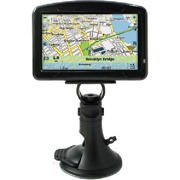
Travel has sure come a long way over the last few decades -- we've gone from struggling with wrinkly maps and squinting at roadside signs to finding our location with a touch of a button, or plotting a course from point A to point B with a single voice-activated command. But when it comes to driving, what's the best device option out there for getting the best, clearest directions? The answers come in several shapes and sizes.
GPS Receivers for Autos
It used to be that GPS devices were thick bricks the size of walkie-talkies, but they've definitely shrunk in size and gained in functionality over the years. Many cars are even equipped with their own GPS systems, and it's worth checking out what's available for your particular model. For a good meat-and-potatoes model that fits a tight budget, the Garmin nuvi 255w is worth checking out. It's an older model, but experts find it holds up favorably compared to more recent versions. The widescreen is clear and readable, mapping and routing functions are fast and accurate, and it has an added bonus of spoken street names.
If you're looking for Bluetooth connectivity or free traffic alerts, the nuvi 255w might not be for you, but it's perfect if want something to get you from A to B with a minimum of fuss. If you're looking for something a bit more advanced, the Garmin nuvi 3790T has lifetime free traffic alerts, plus more data than you can shake a stick at, including elevation, driving direction, current time, current speed (and speed limit), time to destination and distance to destination.
Smartphones
Pretty soon our phones will probably be able to cook breakfast, lunch and dinner for us -- in the meantime, they're serving up some pretty meaty GPS functions. Whether you've got a Droid or an iPhone, you should be able to access GPS functionality. For ease of use (not to mention lack of cost), Google Maps Navigation is a solid option for basic GPS functions; it can even work if you don't have GPS functionality on your phone, as it determines your location via triangulating your cell phone signal. If you do a lot of international traveling, Ovi Maps (for Nokia phones) offers detailed maps and directions for locations spanning the globe, and you find specific destinations on maps.ovi.com and send them to your phone.
When it comes to the two current heavyweights in the smartphone industry, Droid and iPhone, the former offers a navigation system tied in with Google Maps and the latter featuring a downloadable application called TomTom. Both GPS programs are spiffy, with 2D and 3D maps, and voice-generated directions. TomTom does cost a bit ($100) while the Google Maps Navigation software comes with all new Droids.
The Bottom Line
So is it worth it to get a completely separate GPS device, compared to having a GPS system in your smartphone? Certainly GPS receivers for your vehicle tend to offer bigger, more readable screens, and the higher-end portable models provide a wealth of features. But if you already have a cell phone and don't necessarily need every data point under the sun, GPS applications for smartphones will likely be more than enough for your needs.









